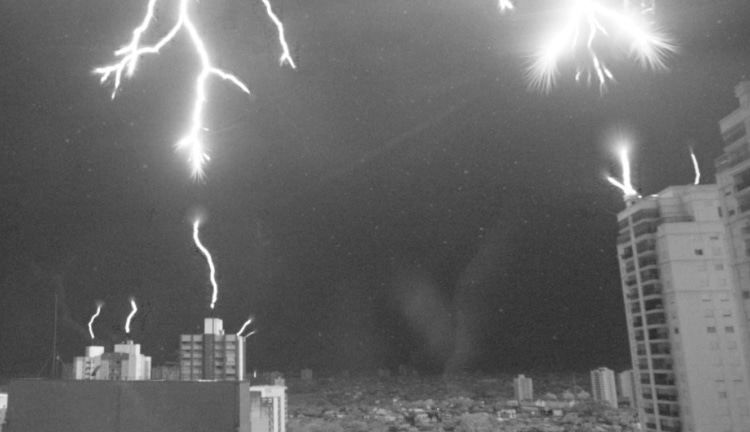
Photo: Diego Rhamon/INPE
Lightning rods are key to keeping our buildings safe from lightning strikes, but the fast and violent nature of this phenomenon makes it hard to see these devices in action with the naked eye. With technology on their side, two Brazilian scientists have managed to capture a thrilling lightning strike using a camera that snaps 40,000 frames per second, showing us how lightning makes its way down and the moment just before it meets the lightning rod.
The footage was captured by Marcelo M.F. Saba, a senior researcher at the National Institute for Space Research (INPE) and grad student Diego Rhamon R. da Silva. While we're used to see lightning coming down from the sky, the images depict a type of lightning bolts known as leaders rising from the top of the buildings, as if trying to meet thunderbolts from the storm halfway. These are not exclusive to lightning rods, as mountaintops, buildings, and other tall objects emit these charges. “Any person standing in an open area can similarly launch an upward connecting discharge from their head or shoulders and be injured by lightning even when not directly struck by it,” the lead researcher told The New York Times.
As for their historic footage, it depicts 31 of these discharges rising from the buildings in the area before the final strike. “The image was captured on a summer evening in São José dos Campos [in São Paulo state] while a negatively charged thunderbolt was nearing the ground at 370 km per second,” Saba explains. “When it was a few dozen meters from ground level, lightning rods and tall objects on the tops of nearby buildings produced positive upward discharges, competing to connect to the downward strike. The final image prior to the connection was obtained 25 millionths of a second before the lightning hit one of the buildings.”
In any storm, that's the moment when the clever design of lightning rods comes into play. Lightning rods are a copper or aluminum rod with wires connected to the ground, and they are installed at the highest point of a construction. While they can't prevent thunderbolts from hitting a certain building, they offer a safer route for it to make it to the ground by offering the path of least resistance. This protects the construction itself and its contents from the extremely high currents and voltages that come with the lightning.
While Saba and da Silva's footage shows plenty of rods in the area, the lightning struck at an unprotected point—a smokestack that was badly damaged according to images captured after the storm. “A flaw in the installation left the area unprotected. The impact of a 30,000-amp discharge did enormous damage,” Saba shared. This reminds us not only of the incredibly destructive power of lightning but also to make sure these devices are correctly set. And according to the researcher, there's no need for the rods to be pricier or more complex; they just have to be well installed. “There are standards that have to be followed by those installing lightning rods. That’s the best we can do for now.”
Two Brazilian scientists have managed to capture the moments before a lightning strike—and how lightning rods protect us from it—by using a camera that snaps 40,000 frames per second.
h/t: [The New York Times]
Related Articles:
Photographer Captures the Moment Rio’s Christ the Redeemer Is Struck by Lightning
Spectacular Gigantic Jets of Upside-Down Lightning Are Being Studied by Scientists
Photographer Captures Rare Sight of Double Moonbow Colliding With Bolt of Lightning
Incredible Photos Capture Powerful Lightning Storms Over Volcano Eruptions






















































































